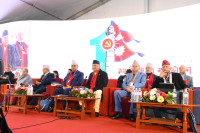National
Students of Hulakdanda see no recourse but to quit studies after Grade 8
The closest secondary school from Manthali Municipality Ward 6 is at least three hours walk and daily commute is impossible, students say.
Tika Prasad Bhatta
Ishwar Shrestha, a 13-year-old eighth-grader at the Hulakdada Basic School in Hulakdada, Manthali Municipality-6, is worried about his secondary education as there are no schools in the village that provide education above the eighth grade. One has to walk at least three hours to reach the nearest secondary school in Bhangeri.
Hulakdada is situated in a difficult geography; it takes several hours to go from one village to another. After completing grade eight, students of the local school are compelled to go to Khurkot in Sindhuli or Bhangeri in Ramechhap for the remaining school years. But not all families can afford to send their children outside Hulakdada for studies.
“Our family’s financial condition is not good,” Ishwar said. “I have only two options before me if I am to continue with my studies—walk for six hours every day to and from the school in Bhangeri or quit studies altogether because I can’t afford to rent a room near the school.”
Hulakdada Basic School was established in 2017. Its principal, Bhakta Bahadur Thapa, says that for a lack of infrastructure, and low student numbers and enrollment rate, the school does not have plans to upgrade to a secondary-level school.
“After completing primary and basic level education, we advise our students to join higher secondary schools in other districts,” Thapa said. “Our school is not equipped to upgrade to a higher level of education. The building is dilapidated and there are no sufficient desks or benches or even teachers.“
From Early Childhood Development grades to grade eight, there are 95 students in the basic school. In grade eight, there are only ten students.
According to Bharat Bahadur Bhattarai, head of the education unit of Manthali Municipality, basic schools must obtain approval to upgrade to secondary-level education from the local unit.
“The office can approve the upgrade only if there are more than 22 students in grade eight, but in Hulakada Basic School there are only ten,” said Bhattarai.
According to Thapa, every year, four to five students drop out of school and go to cities like Kathmandu to join the labour force after completing their basic education. “Only some parents who can afford to rent a room for their wards send them to other districts for higher education,” said Thapa.
Most guardians say they would want to see their wards pursue higher studies if there were higher educational institutions in the village itself.
“If there was a secondary school in the village, my son would continue his education,” said Sabitra Shrestha, Ishwar’s mother. “But he plans to drop out because we won’t be able to finance his education elsewhere.”
Dawa Tamang, chairman of the school management committee, is aware of the fact that students are quitting their studies due to the lack of a secondary school in the village. But he says he is yet to devise a plan to solve the problem. “We don’t have any tangible plans as of now but we will soon find a way to resolve this issue,” he said.
Mandira Shahi, whose son dropped out of school last year, says her financial situation did not support sending him to the secondary school in Khurkot or Bhangeri. “We can’t send our children to another place without renting a room and providing other essentials,” she said. “So my son is planning to discontinue his studies.”




 8.12°C Kathmandu
8.12°C Kathmandu (1).jpg)















